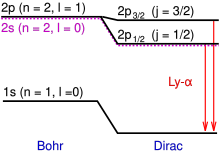A | B | C | D | E | F | G | H | CH | I | J | K | L | M | N | O | P | Q | R | S | T | U | V | W | X | Y | Z | 0 | 1 | 2 | 3 | 4 | 5 | 6 | 7 | 8 | 9
The Lyman-alpha line, typically denoted by Ly-α, is a spectral line of hydrogen (or, more generally, of any one-electron atom) in the Lyman series. It is emitted when the atomic electron transitions from an n = 2 orbital to the ground state (n = 1), where n is the principal quantum number. In hydrogen, its wavelength of 1215.67 angstroms (121.567 nm or 1.21567×10−7 m), corresponding to a frequency of about 2.47×1015 Hz, places Lyman-alpha in the ultraviolet (UV) part of the electromagnetic spectrum. More specifically, Ly-α lies in vacuum UV (VUV), characterized by a strong absorption in the air.
Fine structure
Because of the spin–orbit interaction, the Lyman-alpha line splits into a fine-structure doublet with the wavelengths of 1215.668 and 1215.674 angstroms.[1] These components are called Ly-α3/2 and Ly-α1/2, respectively.
The eigenstates of the perturbed Hamiltonian are labeled by the total angular momentum j of the electron, not just the orbital angular momentum l. In the n = 2, l = 1 orbital, there are two possible states, with j = 1/2 and j = 3/2, resulting in a spectral doublet. The j = 3/2 state has a higher energy and so is energetically farther from the n = 1 state to which it is transitioning. Thus, the j = 3/2 state is associated with the more energetic (having a shorter wavelength) spectral line in the doublet.[2]
Observation
Since the hydrogen Lyman-alpha radiation is strongly absorbed by the air, its observation in laboratory requires use of vacuumed spectroscopic systems. For the same reason, Lyman-alpha astronomy is ordinarily carried out by satellite-borne instruments, except for observing extremely distant sources whose redshifts allow the line to penetrate the Earth atmosphere.
The line was also observed in antihydrogen.[3] Within the experimental uncertainties, the measured frequency is equal to that of hydrogen, in agreement with predictions of quantum electrodynamics.
See also
References
- ^ Kramida, Alexander; Ralchenko, Yuri (1999), NIST Atomic Spectra Database, NIST Standard Reference Database 78, National Institute of Standards and Technology, retrieved 2021-06-27
- ^ Draine, Bruce T. (2010). Physics of the Interstellar and Intergalactic Medium. Princeton, N.J.: Princeton University Press. p. 83. ISBN 978-1-4008-3908-7. OCLC 706016938.
- ^ Ahmadi, M.; et al. (22 August 2018). "Observation of the 1S–2P Lyman-α transition in antihydrogen". Nature. 560 (7720): 211–215. doi:10.1038/s41586-018-0435-1. PMC 6786973. PMID 30135588.
>Text je dostupný pod licencí Creative Commons Uveďte autora – Zachovejte licenci, případně za dalších podmínek. Podrobnosti naleznete na stránce Podmínky užití.
Text je dostupný za podmienok Creative
Commons Attribution/Share-Alike License 3.0 Unported; prípadne za ďalších
podmienok.
Podrobnejšie informácie nájdete na stránke Podmienky
použitia.


